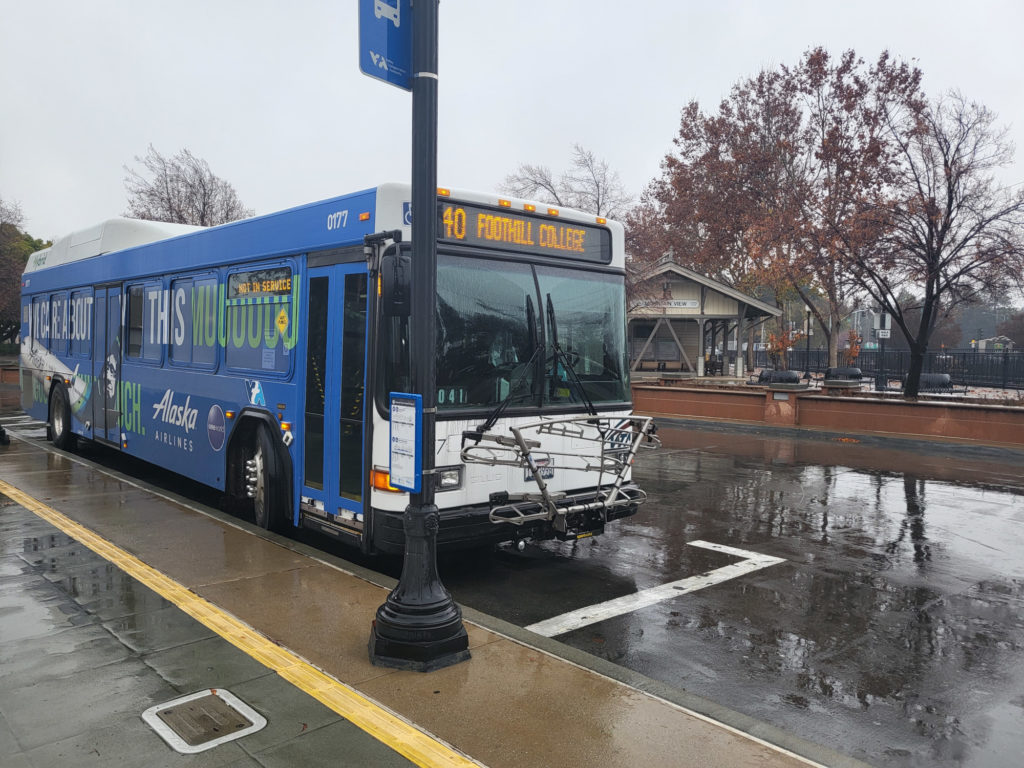
Below are some tips to help you travel during these storms this week. These tips are based on experience in riding buses and trains during big rainstorms and even snowstorms on the East Coast.
Table of Contents
- The Basics
- Boarding a Bus or Train
- Riding the Bus or Train
- Leaving the Bus or Train
- We’re All In This Together
The Basics
- Work from home IF AT ALL POSSIBLE. Make arrangements with your manager to work from home. This is also known as telecommuting. This minimizes the chances you are extremely delayed or end up in an accident in the middle of the storm.
- Give yourself additional time from what it normally takes to travel on VTA, Caltrain or ACE. This is because buses and trains must run slower than normal to avoid the expected accidents and flooding. Also, leftover dust on the pavement and tracks mixed with water makes for a slippery surface. That means trains and buses require a longer distance to stop, hence the need to run slower than normal.
- Drive SLOWLY. Wipers on, headlights on. If you must drive during the storm, make sure to turn your headlights on in addition to your windshield wipers. This is California State LAW. Also, driving slower than you normally would (5-10 mph below posted speed limits) can help prevent you from being in an accident during the storms.
- Watch TV, listen to the radio, or read online for storm updates. Local TV and radio stations will have updates on road closures in Silicon Valley due to the storm. Where possible we’ll also have local transit updates from @svtransitupdts on Twitter. You can also help others by reporting storm-related delays on VTA or Caltrain.
Boarding a Bus or Train
- Make room for those who need it at shelters. Allow the physically disabled, elderly, or women who are pregnant and/or with young children to sit and stand in bus or train shelters to help keep them dry. As a good gesture, and if no shelter is nearby, allow someone who needs to be dry space underneath your umbrella,
- Stand as far as possible from the street curb or train tracks. This keeps you from being sprayed by water from oncoming cars or trains. If there is flooding at a bus stop, wait away from the flooded area to avoid being sprayed, or, if possible, board at a safer bus stop.
- Do not run on train platforms or near bus stops. This helps you avoid “slip and fall” accidents and injuries due to the rain on what was dry pavement. Give yourself at least 20% more time than normal to arrive at your bus or train stop for your transit ride.
- When the bus or train arrives, stand clear of the opening doors. This allows exiting passengers to open their umbrellas they may have. It also helps speed unloading and boarding. When you block the exits of a bus or train at the stop, you help slow down the system and delay others – including yourself.
Riding the Bus or Train
- Keep the bus or train aisles clear. Place your wet umbrella or bag(s) under your seat and away from the aisles. If your bus or train has an overhead luggage rack (found on the new VTA express buses and Caltrain rail cars), use the overhead racks to store your dry belongings. This allows others to quickly board and leave the bus or train as needed. It also helps prevent slipping on the wet floor of the bus or train, causing an injury.
- Keep wet umbrellas or bags off the seats. Remember: one person, one fare, one seat. See the prior tip above on what to do with those wet belongings instead. This allows room for others to be seated as needed. This also keeps the bus and train seats dry and clean for others to use.
- Also, make sure follow these additional tips on how to conduct yourself when riding any bus or train.
Leaving the Bus or Train
- Take ALL of your personal belongings – wet AND dry – with you. Ultimately, YOU are responsible for your personal belongings when leaving a bus or train.
- Move a safe distance from the bus or train as soon as possible. This prevents you from being sprayed by water coming from the bus or train as it pulls away.
- Do not run on or near train platforms or bus stops. This helps you avoid “slip and fall” accidents and injuries due to the rain on what was dry pavement. . Make sure you give yourself additional time to reach your bus stop or train platform. This proactively prevents you from having to rush and run in the rain and slippery conditions to make your bus or train.
We’re All In This Together
Do you have any additional wet weather transit tips? If so, please email the group and they will be posted here.
It is hoped that these tips will help keep you and others safe, sane, and dry when rain occurs in Silicon Valley.
Eugene Bradley
Founder, Silicon Valley Transit Users